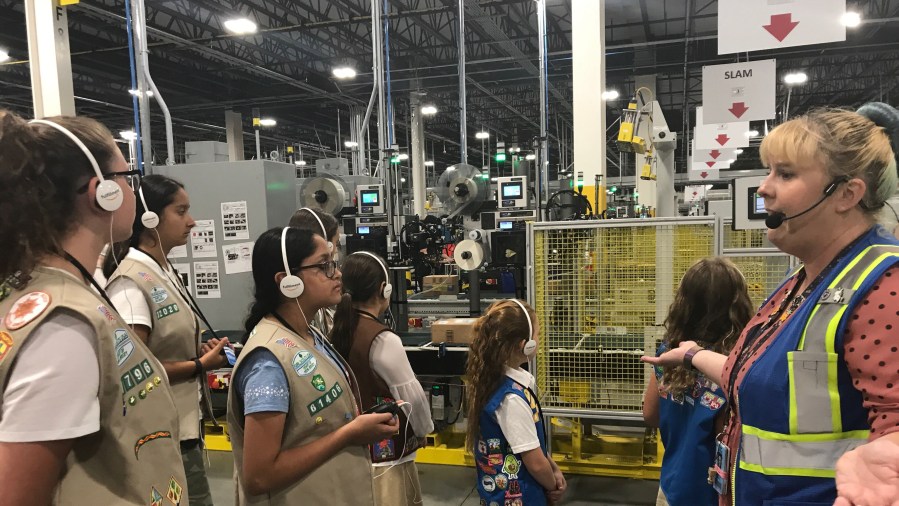Amazon wants the public to know its warehouses are fun enough for the Girl Scouts

When a tour group enters the Amazon warehouse in Edison, New Jersey, the first thing each person receives is a pair of headphones and a radio.
“If you look at your radios, everyone should be on letter E. Is anyone not on letter E?”
Amazon guide Regan Quilty is talking to a group of Girl Scouts for this particular tour. They’re listening to her on a radio frequency because the warehouse — or fulfillment center, to use Amazon’s term for it — is really loud. There are squeaking jacks lifting pallets of stuff, 12 miles of rumbling conveyor belts, and periodically, buzzers let you know when a belt is stopping or starting back up.
Amazon wants people to hear — and see — all of this. The company is expanding its public tours program to 23 warehouses, up from just six. The company has over 100 of these fulfillment centers in the United States. They are key to the company’s operations: products come in, get organized, packaged and shipped out to customers.
But they don’t have a reputation for being great places to work. The U.S. Supreme Court ruled this week that workers can move forward with a lawsuit to force Amazon to pay them for time they spend getting searched by security after their shifts are over. Last week, workers near Minneapolis walked off the job over a cap on their hours. There were also protests in Sacramento over the company’s time off policy. And last year, there were reports, which Amazon denied, about employees urinating in bottles at a United Kingdom warehouse to avoid taking bathroom breaks.
So Amazon is trying to counter that narrative.
“Part of it is to really be transparent with the general public and with our customers about what happens inside of an Amazon fulfillment center,” said Rachael Lighty, an Amazon spokeswoman. “We want people to know why we’re so proud and to see for themselves how safe our fulfillment centers are.”
Sunil Gupta, who studies business strategy as a professor at Harvard University, said if the tours are successful, that could make customers feel closer to the company.
“It’s like if you go to a restaurant, and if you have an open kitchen where you can see the cook actually making the food, it suddenly tastes good,” Gupta said. “There are studies which show that if you see something being made, it tastes different than if it’s just pre-packaged and shipped to you.”
During the tour, the Girl Scouts observe the process of sorting millions of items into Amazon’s system. All items in this warehouse are under 18 inches in length. Things arrive from the outside world — jars of pork rinds, pairs of socks, tubes of caulk. Workers then place the items into slots in big towers of stuff called pods.

“I’m going to pick up the item, make sure the item is not damaged. Then I’m going to scan the item,” said Yogi Kotak, an Amazon warehouse worker, demonstrating with a Spanish language dictionary. “Then I pick up the next item, do the same thing and continue.”
As soon as Kotak scans the item, a clock appears on the screen above her, counting the seconds since she last put an item away. Amazon says it uses these kinds of timers to give employees a better sense of how they’re doing.
Once Kotak is done, an autonomous robot moves the pod away. It will stay on the floor until someone buys an item that’s stored in it, at which point it’ll move to another worker, who begins assembling an outgoing order. When the pods are all moving around, they sort of look like blocks in a massive game of Tetris.
“They have cameras on the bottom and on either side, so they can see where they are going,” said tour guide Quilty. “You can see how these guys get very close to each other, but there are sensors, so they’ll never crash into each other.”
This choreography between robots and humans is one of the things that most stood out to the Girl Scouts on the tour.

“I thought it was all just robots who did it, and no people at all,” said 8-year-old Girl Scout Anna Matos. “It just says that, these days, people really want to work hard, and they just don’t want to let robots do everything.”
Another one of Amazon’s stated goals with these tours is to inspire kids. In the case of Matos’ sister, 12-year-old Sofia, it may have worked.
“I have hopes to become a scientist one day,” Matos said. “Hopefully, maybe even a programmer for the robots. That would be very fun.”
The way automation is changing work, by the time Matos enters the workforce, being a robot programmer might be the only human job left in an Amazon warehouse.
The future of this podcast starts with you.
Every day, the “Marketplace Tech” team demystifies the digital economy with stories that explore more than just Big Tech. We’re committed to covering topics that matter to you and the world around us, diving deep into how technology intersects with climate change, inequity, and disinformation.
As part of a nonprofit newsroom, we’re counting on listeners like you to keep this public service paywall-free and available to all.
Support “Marketplace Tech” in any amount today and become a partner in our mission.
















